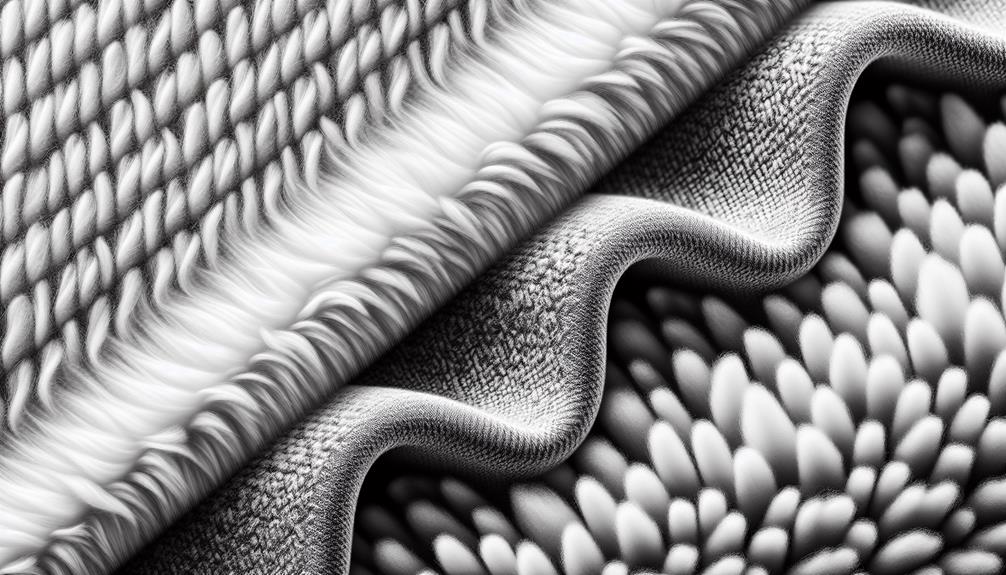When it comes to choosing between flannel and fleece, the key differences lie not only in their names but also in their fabric composition and texture. Understanding these distinctions can help you make informed decisions when selecting the right material for your next cozy purchase.
So, let's unravel the mystery behind what truly sets flannel and fleece apart regarding warmth, durability, and more.
Table of Contents
Key Takeaways
- Flannel offers a cozy, warm feel with a brushed finish.
- Fleece provides superior insulation and lightweight warmth.
- Fleece is more durable, easy to clean, and retains shape.
- Understanding their distinct characteristics helps choose the right fabric for different needs.
Fabric Composition
When comparing flannel and fleece, it's important to understand their fabric compositions to distinguish between the two. Flannel is typically made from cotton, wool, or a blend of both, offering excellent breathability while still providing warmth.
On the other hand, fleece is usually crafted from synthetic materials like polyester, which makes it lightweight despite its insulating properties. This difference regarding breathability vs. weight means that flannel may be a better choice for those who prefer natural fibers and need a balance between warmth and ventilation, while fleece is ideal for individuals seeking a lighter option that still offers considerable warmth.
Regarding flexibility vs. pilling, flannel can be prone to pilling due to the nature of its fibers, especially if it's of lower quality. Fleece, being a synthetic material, tends to be more flexible and less prone to pilling, making it a durable choice for those who prioritize longevity and ease of care.
Ultimately, understanding these fabric compositions can help you make an informed decision based on your preferences for breathability, weight, flexibility, and resistance to pilling.
Texture and Feel
Moving from understanding the fabric compositions of flannel and fleece, let's now explore the distinct textures and feel of these two fabrics.
Flannel, known for its brushed finish, has a softness that feels cozy against the skin. Its texture is typically warmer and more substantial compared to fleece. When you touch flannel, you'll notice a slightly fuzzy surface that adds to its comfort.
On the other hand, fleece, made from synthetic fibers, has a smoother texture but still maintains a high level of softness. It feels lightweight yet provides excellent insulation, making it a popular choice for colder weather. Fleece often gives a plush, velvety sensation that's both gentle and pleasant.
While flannel offers a traditional, classic feel, fleece brings a modern touch with its smooth and snuggly texture. Both fabrics excel in providing warmth and comfort, with flannel leaning towards a more traditional, rustic charm, and fleece offering a contemporary, versatile appeal.
Insulation and Warmth
Flannel and fleece differ in their insulation capabilities and warmth retention. When it comes to insulation efficiency, fleece tends to outperform flannel. Fleece is made of synthetic materials that are designed to trap heat close to the body, providing excellent warmth without adding bulk. On the other hand, flannel, typically made of cotton, offers less insulation and may not be as effective in extreme cold conditions.
One of the key benefits of fleece is its layering potential. Fleece jackets or blankets can be easily layered under a coat for added warmth without feeling too bulky. This makes fleece a versatile option for staying cozy in varying temperatures. Flannel, while still providing some warmth, may not offer the same layering benefits due to its thicker nature.
Durability and Maintenance
Durability and maintenance, fleece typically requires less upkeep compared to flannel due to its synthetic composition. Fleece is known for its resilience, making it a durable choice for various uses. Its synthetic fibers are less prone to wear and tear, offering longevity compared to natural fibers like flannel.
When it comes to care, fleece is relatively easy to clean and maintain. It is machine washable, dries quickly, and does not require ironing, which simplifies the cleaning process. Additionally, fleece retains its shape and softness even after multiple washes, adding to its appeal for everyday use.
To summarize the differences in durability and maintenance between fleece and flannel, let's look at the table below:
| Aspect | Fleece | Flannel |
|---|---|---|
| Longevity | Durable | Less durable |
| Resilience | Resistant to wear | Prone to wear |
| Cleaning | Easy care, machine washable | Requires more upkeep |
Suitable Uses
When considering the practicality of fleece and flannel, it's important to understand their distinct suitable uses in various settings.
- Outdoor activities: Fleece excels in outdoor activities due to its moisture-wicking properties, making it ideal for hiking, camping, and other adventures where staying dry is essential.
- Bedding: Flannel shines in the bedroom, offering warmth and comfort during colder nights. Its soft, insulating nature makes it perfect for cozying up in bed.
- Fashion: Fleece is a popular choice in the fashion world, often used in jackets, hoodies, and sweatpants for its lightweight warmth and versatility.
- Home decor: Flannel is frequently employed in home decor items like blankets, throw pillows, and curtains, adding a touch of snugness and style to living spaces.
Understanding these distinct uses allows individuals to make informed decisions when selecting between fleece and flannel for different purposes, ensuring both functionality and comfort in various aspects of life.
Frequently Asked Questions
Can Flannel and Fleece Be Used Interchangeably in Sewing Projects?
In sewing projects, flannel and fleece can be used interchangeably based on personal preference. Both fabrics offer cozy warmth, but consider the texture and weight desired for the project. Experiment to find the best fabric choice for your needs.
Are Flannel and Fleece Suitable for People With Sensitive Skin?
For those with sensitive skin, fabric choices matter. When considering hypoallergenic options, selecting the right fabric is essential. Flannel and fleece can both be suitable, but personal preference and individual reactions should guide fabric selection.
Do Flannel and Fleece Shrink in the Wash?
I've noticed shrinkage concerns with both flannel and fleece. To prevent sizing issues, I recommend washing them in cold water and air drying. Following proper fabric care instructions will help maintain the quality of these materials.
Can Flannel and Fleece Be Worn in Warmer Climates?
I love layering options in warmer climates. Lightweight alternatives like breathable cotton work well. Fashion trends embrace versatility. Flannel and fleece might be too warm, but there are better choices for staying comfortable.
Are There Any Environmental Concerns Associated With the Production of Flannel and Fleece Fabrics?
There are environmental concerns linked to flannel and fleece production, such as excessive water use, chemical pollution, and contribution to microfiber pollution. Sustainability concerns arise due to these factors, prompting a need for eco-friendly alternatives.
- Does Carhartt Make Gore-Tex Coats? - July 2, 2025
- Does a Non-Gore-Tex Drysuit Still Keep You Dry? - July 2, 2025
- Can You Use Mink Oil on Gore-Tex Leather Boots? - July 2, 2025




